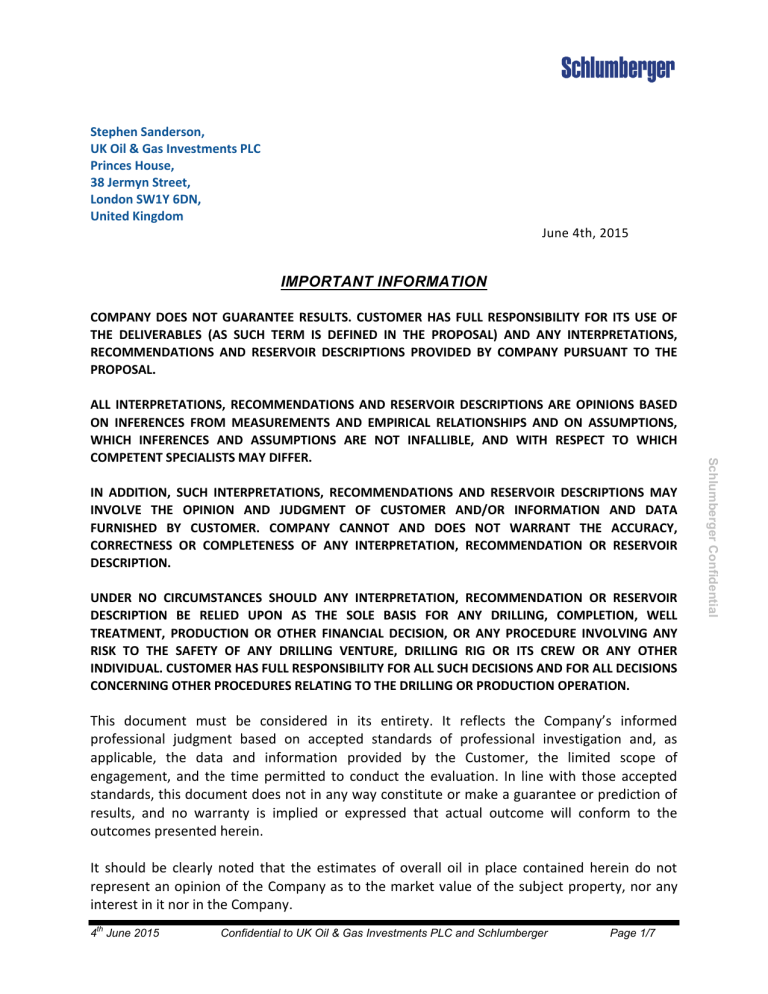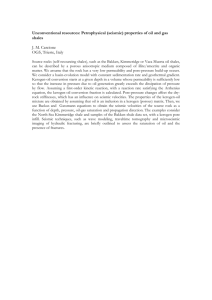Petrophysical Evaluation of the Horse Hill-1 Well

Stephen Sanderson,
UK Oil & Gas Investments PLC
Princes House,
38 Jermyn Street,
London SW1Y 6DN,
United Kingdom
June 4th, 2015
IMPORTANT INFORMATION
COMPANY DOES NOT GUARANTEE RESULTS. CUSTOMER HAS FULL RESPONSIBILITY FOR ITS USE OF
THE DELIVERABLES (AS SUCH TERM IS DEFINED IN THE PROPOSAL) AND ANY INTERPRETATIONS,
RECOMMENDATIONS AND RESERVOIR DESCRIPTIONS PROVIDED BY COMPANY PURSUANT TO THE
PROPOSAL.
ALL INTERPRETATIONS, RECOMMENDATIONS AND RESERVOIR DESCRIPTIONS ARE OPINIONS BASED
ON INFERENCES FROM MEASUREMENTS AND EMPIRICAL RELATIONSHIPS AND ON ASSUMPTIONS,
WHICH INFERENCES AND ASSUMPTIONS ARE NOT INFALLIBLE, AND WITH RESPECT TO WHICH
COMPETENT SPECIALISTS MAY DIFFER.
IN ADDITION, SUCH INTERPRETATIONS, RECOMMENDATIONS AND RESERVOIR DESCRIPTIONS MAY
INVOLVE THE OPINION AND JUDGMENT OF CUSTOMER AND/OR INFORMATION AND DATA
FURNISHED BY CUSTOMER. COMPANY CANNOT AND DOES NOT WARRANT THE ACCURACY,
CORRECTNESS OR COMPLETENESS OF ANY INTERPRETATION, RECOMMENDATION OR RESERVOIR
DESCRIPTION.
UNDER NO CIRCUMSTANCES SHOULD ANY INTERPRETATION, RECOMMENDATION OR RESERVOIR
DESCRIPTION BE RELIED UPON AS THE SOLE BASIS FOR ANY DRILLING, COMPLETION, WELL
TREATMENT, PRODUCTION OR OTHER FINANCIAL DECISION, OR ANY PROCEDURE INVOLVING ANY
RISK TO THE SAFETY OF ANY DRILLING VENTURE, DRILLING RIG OR ITS CREW OR ANY OTHER
INDIVIDUAL. CUSTOMER HAS FULL RESPONSIBILITY FOR ALL SUCH DECISIONS AND FOR ALL DECISIONS
CONCERNING OTHER PROCEDURES RELATING TO THE DRILLING OR PRODUCTION OPERATION.
This document must be considered in its entirety. It reflects the Company’s informed professional judgment based on accepted standards of professional investigation and, as applicable, the data and information provided by the Customer, the limited scope of engagement, and the time permitted to conduct the evaluation. In line with those accepted standards, this document does not in any way constitute or make a guarantee or prediction of results, and no warranty is implied or expressed that actual outcome will conform to the outcomes presented herein.
It should be clearly noted that the estimates of overall oil in place contained herein do not represent an opinion of the Company as to the market value of the subject property, nor any interest in it nor in the Company.
4 th
June 2015 Confidential to UK Oil & Gas Investments PLC and Schlumberger Page 1/7
The Company has not independently verified any information provided by or at the direction of the Customer, and has accepted the accuracy and completeness of this data. The Company has no reason to believe that any material facts have been withheld from it, but does not warrant that its inquiries have revealed all of the matters that a more extensive examination might otherwise disclose.
The opinions expressed herein are subject to, and fully qualified by, the generally accepted uncertainties associated with the interpretation of geoscience and engineering data and do not reflect the totality of circumstances, scenarios and information that could potentially affect decisions made by its recipients and/or actual results. The opinions and statements contained in this document are made in good faith and in the belief that such opinions and statements are representative of prevailing physical and economic circumstances.
The accuracy of any reserve or resource estimate is a function of the quality of the available data and of engineering and geological interpretation. Results of drilling, testing and production that post-date the preparation of the estimates may justify revisions, some or all of which may be material. Accordingly, reserve or resource estimates are often different from the quantities of oil that are ultimately recovered, and the timing and cost of those volumes that are recovered may vary from that assumed.
In performing its services pursuant to the Proposal, the Company is not aware that any conflict of interest has existed. As an independent consultancy, the Company is providing impartial technical advice within the energy sector. The Company’s remuneration was not in any way contingent on the contents of the Report.
In the preparation of this document, the Company has maintained, and continues to maintain, a strict independent consultant-client relationship with the Customer. Furthermore, the management and employees of the Company have no interest in any of the assets evaluated or related with the analysis performed as part of the Report.
The Company is not in a position to attest to property title or rights, conditions of these rights including environmental and abandonment obligations, and any necessary licenses and consents including planning permission, financial interest relationships or encumbrances thereon for any part of the appraised properties.
The Company has not undertaken a site visit or an inspection because it was not considered relevant for the purpose of this report. As such, the Company is not in a position to comment on the operations or facilities in place, their appropriateness and condition, and whether they are in compliance with the regulations pertaining to such operations. Further, the Company is not in a position to comment on any aspect of health, safety or environment of such operation.
4 th
June 2015 Confidential to UK Oil & Gas Investments PLC and Schlumberger Page 2/7
‘Petrophysical Evaluation of the Horse Hill-1 Well’
Executive Summary Report
A petrophysical evaluation was performed on the tight Jurassic mudstone and limestone oil reservoirs in addition to the overlying conventional Jurassic Upper Portland sandstone oil discovery drilled by the Horse Hill-1 well “HH-1”, located in UK onshore licence PEDL 137. The models used for the tight oil evaluation were based on proprietary models developed by
Schlumberger.
Using this methodology an overall estimated Oil In Place (OIP), for the conventional and tight oil reservoirs specifically at the HH-1 location, is 271.4 million barrels of oil (MMBO) per square mile. This total includes a summation of the Upper Portland sandstone plus all deeper potential
Jurassic tight mudstone and limestone reservoir intervals, from the Upper Jurassic Kimmeridge, starting at a measured depth (“MD”) of 2482ft (2215 ft true vertical depth sub-sea or ‘tvdss’), through the Kimmeridge, Oxford Clay and Lias sections down to the Rhaetic and Palaeozoic sections at the base of the well at 8815 ft MD (7942 ft tvdss).
The summary table, Table 1, captures the calculated OIP estimates for the main stratigraphic units drilled in HH-1. The Kimmeridge and Lias sections have been broken down into sub intervals for further granularity. The OIP were calculated using the true vertical depths for the top and base of each unit.
The highly organic source rock facies in the Middle Kimmeridge second interval and the Lower
Kimmeridge are both calculated to have generated the most significant OIP numbers.
When attempting large scale resource assessments for the Weald basin the thermal maturity of the Jurassic section, and specifically that of the Kimmeridge, has always been a significant uncertainty, due to lack of reliable constraining information. Previous reports, including a previous assessment by Schlumberger, suggest that the Kimmeridge was primarily immature throughout the Weald. However the HH-1 logs and the well’s location in the basin, together with the rock cuttings and geochemical analyses, indicate a higher level of maturity of the
Kimmeridge than we have previously taken into account when building petroleum systems models for this area.
This does not necessarily mean that the Kimmeridge is mature enough to contain economically viable quantities of producible oil in the Weald Basin but it is key new information to be utilized in updating existing predictive models of the Weald.
4 th
June 2015 Confidential to UK Oil & Gas Investments PLC and Schlumberger Page 3/7
4 th
June 2015
Table 1: OIP estimates for key stratigraphic horizons in the HH-1 well
TOTAL
Formation MD OIP
(ft) MMBO/mi2
Main Upper Portland Sandstone 2038
U. Portland shales/silts/thin sands 2148
Lower Portland Sandstone
Kimmeridge (Total)
2320
2482
U. Kimmeridge
Kimmeridgian Micrite1
M. Kimmeridge 1
Kimmeridgian Micrite2
2482
2825
2931
3083
M. Kimmeridge 2
Kimmeridgian Micrite3
L. Kimmeridge Clay
Top Corallian
Corallian Limestone
Oxford Clay
Kellaways Beds
Cornbrash
Great Oolite
Fullers Earth
Inferior Oolite**
3184
3450
3479
4430
5001
5050
5466
5518
5521
5685
5800
Lias (Total)
Upper Lias
Middle Lias
Lower Lias
Mercia Mudstone
Palaeozoic
Total Depth
6370
6370
6711
7072
8288
8507
8815
271.4
53.2
1.1
60.3
-
-
19.7
-
-
-
-
-
16.2
-
-
176.3
21.1
4.4
26.4
9.3
59.2
8.0
27.1
24.2
-
-
-
**see note in text below
Confidential to UK Oil & Gas Investments PLC and Schlumberger Page 4/7
In the Kimmeridge section three dominantly micritic limestone intervals have been identified within the section with varying OIP estimates. Of the three micrites, the middle member has the highest overall OIP value calculated. The upper two micrites could have a conventional pore system encased within the organic facies of the Kimmeridge. This would be a system akin to the
Bakken Shale in North America.
In the Jurassic Lias section a separation of the OIP calculation into Upper, Middle and Lower sections has been performed with the Middle and Lower Lias exhibiting similar volumes in place. It should also be noted that a potential tight conventional oil reservoir with low oil saturations was also interpreted in the Middle Jurassic Inferior Oolite limestone section. This is not reported in Table 1 as further work and cuttings analyses are necessary and ongoing in order to help calibrate the log interpretation in this section to solidify the calculated OIP.
As a result of the HH-1 well analysis findings, it is recommended to further refine the basin’s overall petroleum resource potential, future wells in the basin should now be designed to log and sample the mudstones and limestones of the Kimmeridge, Oxford and Lias sections utilizing technologies and interpretation techniques established in other productive tight oil plays in the world.
Next Steps:
The logs of a number of additional wells within the Horse Hill licences and wells surrounding
HH-1 have been made available by UK Oil & Gas Investments PLC (“UKOG”) to proceed to the next phase of performing a localized resource assessment of licences PEDL 137 and PEDL 246.
This analysis will also incorporate the Horse Hill-1 interpretation completed in this initial study.
As UKOG has other licenced acreage in the Weald, and subsequent to this localized assessment the final stage of the evaluation process will be to conduct on UKOG’s behalf an overall assessment of the Weald Basin, covering approximately 5500 km
2
, using the well-established
Rapid Resource Assessment (RRA) approach, an international emerging play exploration workflow that has been deployed around the world in places such as the Middle East, North
Africa, China, Western Europe and South America. The RRA has been proven to provide key decision making criteria for the early exploration and appraisal phase for tight reservoirs and hybrid play targets. The results of the RRA will assist UKOG in assessing the conventional and tight oil potential of its licences elsewhere in the Weald and provide decision making criteria for future exploration and appraisal drilling.
4 th
June 2015 Confidential to UK Oil & Gas Investments PLC and Schlumberger Page 5/7
Addendum 1: Petrophysical Evaluation Methodology
Input data for this evaluation included the following logs:
Spectral gamma ray
Electrical induction
Thermal neutron
Gamma-gamma density
Photoelectric
Nuclear magnetic resonance (NMR).
The following cuttings analyses were also included:
XRD
Total organic carbon (TOC) from RockEval pyrolysis.
The evaluation software included the following steps:
1. Environmental corrections for spectral gamma ray and thermal neutron logs. Corrections necessary for hole size, mud type, mud weight, temperature, pressure, mud salinity.
2. Reprocessing of NMR log.
3. Editing of NMR, bulk density, and thermal neutron porosity for hole effects—primarily washout.
4. Estimation of TOC content from logs. A Passey model was employed using deep electrical induction and bulk density as inputs logs. The baseline value for induction is 4.5 ohm-m; the baseline for bulk density is 2.6 g/cm 3 . A thermal maturity of 0.65 Ro was used for the section above the Lias; a thermal maturity of 0.9 Ro was used for the Lias. This methodology can calculate TOC in zones that are not organic; hence, this log was edited to remove apparent TOC in the Portland, Sands, upper two Kimmeridge Micrites, and the Oolites.
5. Pyrite volume was estimate using an algorithm published by Schmoker and Hester (1983) based on kerogen content.
6. The petrophysical model used the following inputs: a. CGR (K+Th gamma ray activity) b. NPHU (environmentally corrected neutron porosity with a limestone matrix) c. RHOB (bulk density) d. U (volumetric photoelectric effect) e. Kerogen content (estimated from TOC in step 4) f. Pyrite content (step 5) g. Shallow and deep electrical induction.
4 th
June 2015 Confidential to UK Oil & Gas Investments PLC and Schlumberger Page 6/7
7. Outputs for the petrophysical model included: a. Illite (based on XRD, the illite was assumed to be a mixture of illite and kaolinite) b. Smectite c. Quartz d. Calcite e. Kerogen f. Pyrite g. Clay bound water (0.1 for Illite and 0.43 for smectite volumes) h. Effective porosity i. Effective water saturation
Effective water saturation was estimated using a Modified Simandoux model with a water salinity of 120 ppk and m = n = 2, a = 1. The salinity of 120 ppk was determined by comparing Rt
(true resistivity) to Ro (calculated resistivity of a water saturated formation). They should match in wet zones. This model may be inadequate for the Oolites where the presence of a complex carbonate reservoir may require tuning of a saturation model to pore characteristics.
Oil in place (OIP) was estimated by using Glaso’s model to account for oil shrinkage and gas coming out of solution. The oil gravity was estimated to be 32 API, gas gravity was calculated at
0.77 based on the mud gas values, and GOR was estimated to be 200 SCF/bbl. Glaso’s will estimate a GOR if one assumes the pore hydrocarbons at on the phase envelope. We input the
200 SCF/bbl as it is likely that the pore hydrocarbons are well above the envelope in the P/T conditions for this well.
Pore pressure was assumed to be hydrostatic—0.43 psi/ft. Formation temperature was calculated assuming a mean annual surface temperature of 50 degF and a bottom hole temperature of 150 degF based on logging tool measurements.
4 th
June 2015 Confidential to UK Oil & Gas Investments PLC and Schlumberger Page 7/7






